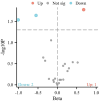Genetic insights into dietary patterns, liposome mediation, and osteoporosis risk: a Mendelian randomization study
- PMID: 39421617
- PMCID: PMC11484406
- DOI: 10.3389/fnut.2024.1389896
Genetic insights into dietary patterns, liposome mediation, and osteoporosis risk: a Mendelian randomization study
Erratum in
-
Erratum: Genetic insights into dietary patterns, liposome mediation, and osteoporosis risk: a Mendelian randomization study.Front Nutr. 2024 Dec 13;11:1532886. doi: 10.3389/fnut.2024.1532886. eCollection 2024. Front Nutr. 2024. PMID: 39734676 Free PMC article.
Abstract
Background: This study examines the indirect causal relationships between dietary habits and osteoporosis, mediated through liposomes, utilizing a two-sample Mendelian randomization (MR) approach. The research leverages genetic variations as instrumental variables to explore the genetic influences on dietary habits, liposomes, and osteoporosis, aiming to unravel the complex interplay between diet, lipid metabolism, and bone health.
Methods: The study utilized genome-wide association studies (GWAS) data for liposomes from Finnish individuals and osteoporosis-related data, alongside dietary factors from the OpenGWAS database. Instrumental variables were selected based on genetic variants associated with these factors, using a strict significance level and linkage disequilibrium threshold. Statistical analysis employed the Inverse Variance Weighted method, weighted median, and mode-based methods within the R environment, complemented by sensitivity analyses to ensure the robustness of the causal inferences.
Results: Findings revealed significant causal relationships between specific dietary components (white rice, cereal, and non-oily fish) and osteoporosis risk, both directly and mediated through changes in liposome levels. Notably, white rice consumption was associated with an increased risk of osteoporosis, while cereal and non-oily fish intake showed protective effects. Further, certain liposomes were identified as mediators in these relationships, suggesting a link between diet, lipid profiles, and bone health.
Conclusion: The study highlights the significant impact of dietary habits on osteoporosis risk, mediated through liposomes. These findings underscore the importance of considering lipidomic profiles in dietary guidance and suggest potential targets for preventing osteoporosis through nutritional interventions.
Keywords: GWAS; Mendelian randomization; causal inference; dietary habits; liposomes; osteoporosis.
Copyright © 2024 Long, Zheng, Gong, Ying and Zhang.
Conflict of interest statement
The authors declare that the research was conducted in the absence of any commercial or financial relationships that could be construed as a potential conflict of interest.
Figures





Similar articles
-
Dissecting Causal Relationships Between Dietary Habits and Diverse Subtypes of Stroke: Mendelian Randomization Study.Nutrients. 2024 Oct 19;16(20):3548. doi: 10.3390/nu16203548. Nutrients. 2024. PMID: 39458542 Free PMC article.
-
Potential causal link between dietary intake and epilepsy: a bidirectional and multivariable Mendelian randomization study.Front Nutr. 2024 Aug 30;11:1451743. doi: 10.3389/fnut.2024.1451743. eCollection 2024. Front Nutr. 2024. PMID: 39279897 Free PMC article.
-
Genetically determined dietary habits and risk of Alzheimer's disease: a Mendelian randomization study.Front Nutr. 2024 Jun 3;11:1415555. doi: 10.3389/fnut.2024.1415555. eCollection 2024. Front Nutr. 2024. PMID: 38887501 Free PMC article.
-
The role of lipid species in Alzheimer's disease onset: A comprehensive Mendelian randomization analysis.Brain Res. 2025 Jan 1;1846:149238. doi: 10.1016/j.brainres.2024.149238. Epub 2024 Sep 13. Brain Res. 2025. PMID: 39278307
-
Plasma proteins, circulating metabolites mediate causal inference studies on the effect of gut bacteria on the risk of osteoporosis development.Ageing Res Rev. 2024 Nov;101:102479. doi: 10.1016/j.arr.2024.102479. Epub 2024 Aug 28. Ageing Res Rev. 2024. PMID: 39214170 Review.
References
-
- Weaver CM, Gordon CM, Janz KF, Kalkwarf HJ, Lappe JM, Lewis R, et al. . The National Osteoporosis Foundation's position statement on peak bone mass development and lifestyle factors: a systematic review and implementation recommendations. Osteoporos Int. (2016) 27:1281–386. 10.1007/s00198-015-3440-3 - DOI - PMC - PubMed
-
- Hejazi J, Davoodi A, Khosravi M, Sedaghat M, Abedi V, Hosseinverdi S, et al. . Nutrition and osteoporosis prevention and treatment. Biomed Res Ther. (2020) 7:3709–20. 10.15419/bmrat.v7i4.598 - DOI
LinkOut - more resources
Full Text Sources

